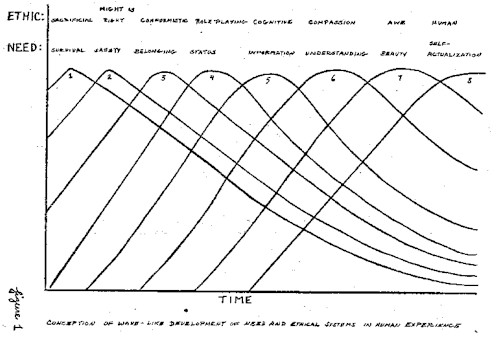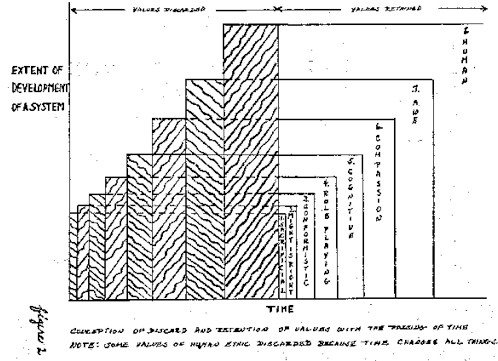 |
 |
|||||||||||||||||||||||
|
|
||||||||||||||||||||||||
 |
||||||||||||||||||||||||
|
The second kind of values inherent in any ethical system would be those, which, in their original modified form, are good for man at any time, anyplace, at whatever level his is operating after the value appears. Valuing individualism is a case in point. Its original form in our society, rugged individualism, robber baron capitalism, is good for man as he operates at the second need and behavioral level. However, this, which has been valued and still is valued by many, is definitely detrimental to the cooperative living required of man at a higher level of operation. It must modify, or it will strangle manís moral development. Figure 1 represents the growth and development of need and ethical systems with time, and depicts in total the rise, decline, discard and retention of values within each ethical system.
In figure 1, the epigenetic principle, that all which grows has a ground plan, is used to depict both need and ethical growth. This principle applies to the individual as well as the species, therefore, one can see what happens in one or the other with time. The diagram presents manís ethical growth as a complex wave phenomenon which at any one time has elements of several ethical systems present. It shows, also, that as the species or individual starts to develop, the lower level system dominates and thereby orders the operation of the embryonic or lasting parts of all other systems. As man solves his problems at a lower level, the next need and ethical system normally swells into prominence, only in turn to be engulfed in a later surging system, provided development is not blocked at some point in time. As each successive wave comes in, some of the old disappears and some of the old is retained. Figure 2 represents the same points in a slightly different form. In figure 2, we see a series of superimposed rectangles. The base is time and the ordinate is the extent of ethical system development. Note, that a part of ethical system 1 (the cross hatched portion) is discarded when ethical system 2 emerges and that still more of system 1 and some of system 2 is discarded when system 3 emerges, etc. Thus, by the time the highest level of ethical and moral behavior is reached, almost all the rules of conduct of system 1 are discarded, while less of the second level system is ultimately discarded than of the first level system, etc.
Figure 3 is included to reinforce the picture of ethical development previously presented and to emphasize two other points.
Ethical growth, like all other growth, is not a straight line phenomenon. The representation in figure 3 depicts how growth proceeds forward to a critical point to be followed by a regression and reorganization before a higher level of ethical behavior emerges. The dipping down represents the regressive reorganization. As it takes place, the figure depicts how man operates, temporarily, at a lower level of ethical behavior than had previously been achieved, and the figure depicts that this regression is periodic. This is most significant because I suspect it is the behavior represented at these critical points of progressive growth that is most often interpreted as decay. The falling back is significant, also, because it signifies reorganization for movement forward to a higher level. Thus, a major sign of decay in customary ethical frames of reference becomes the all important sign of growth in the theory presented herein. << previous | 5 | >>next |
||||||||||||||||||||||||
Copyright 2001 NVC Consulting


